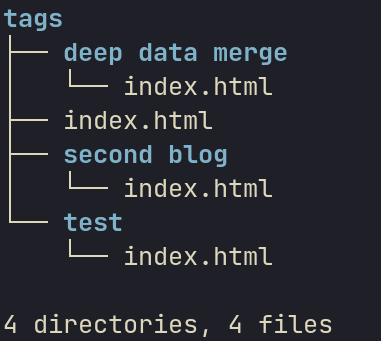Reverse Index
Reverse indices are slight bit harder to grasp, so stick with me here! Say you have two blogs with the following front matter :
content/blog1.md:
---
template : "blog.html"
title : "First blog testing Markdown elements"
date : "01-20-2002"
link : "/blogs/blog1"
author : ["P K Navin Shrinivas"]
tags : ["test","deep data merge"]
forwardindex : blog
reverseindex : ["author","tags"]
content/blog2.md:
---
template : "blog.html"
title : "Second blog to test indexs"
date : "01-20-2002"
link : "/blogs/blog2"
author : ["Anirudh Rowjee"]
tags : ["test","second blog"]
forwardindex : blog
reverseindex : ["author","tags"]
---
Note : unlike 11ty, reverse inices (that are similar to collections) can be done on any number of tags as you wish.
Now in the above example, you will have the following :
- A list of frontmatter with the tag
test. - A list of frontmatter with the tag
deep data merge. - A list of frontmatter with the tag
second blog. - A list of fronmatter of posts with author
P K Navin Shrinivas. - A list of fronmatter of posts with author
Anirudh Rowjee.
What sapling does with the reverse indices. IMPORTANT PART
It by default tries to generate a page for each of the value it found in those tags. It seraches for the template for this page in /templates/reverseindex.
IT WILL GIVE AN ERROR IF IT DOESNT FIND A TEMPLATE FOR EACH TAG IT INDEXED ON.
In the above case, we need two templates, namely : templates/reverseindex/tags.html and templates/reverseindex/author.html
Note : you can feel free to leave it empty, I does't render anything in that case.
The templates/reverseindex/tags.html will look something like this :
<header>
{% block header %}
<h1>Posts with the tag : {{reverseindexon}}</h1>
{% endblock header %}
</header>
{% block content %}
<div class="postlist">
{% for i in reverseindex %}
<aside>
<a href={{ i.link }}>
<h3>{{ i.title }}</h3>
<p><b>Date : </b>{{ i.date }}</p>
</a>
<div class="tagslist">
tags :
{% for k in i.tags %}
<a href="/tags/{{k}}/"><code>{{k}}</code></a>
{% endfor %}
</div>
{% endfor %}
</aside>
</div>
{% endblock content %}
The important variables to focus on is reverindexon which contains the value in the tag this reverseindex list will contain. reverseindex is the list itself.
sapling will feed this template one by one with all the values it find in the tags attribute wherever we have asked for a reverse index!
In the end of this process you'll have a structure like this in the static folder :
